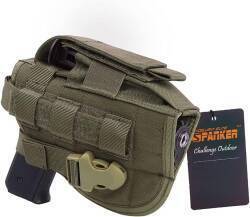
M1911 Pistol
The M1911 Pistol
John Browning designed the M1911 pistol which was the entire U.S. military's standard sidearm from 1911 through 1985, through World War I, World War II, Korea, and Vietnam. It is still in use by some units in the U.S. Marine Corps, the U.S. Navy, and the U.S. Army Special Forces, as well as foreign military and both U.S. and foreign law enforcement. Its short-recoil self-loading system was very innovative for 1911 and was widely copied. Browning's design has been the dominant one for centerfire semiautomatic pistols through the 20th century and into the 21st. The M1911 was designed in parallel with its .45 ACP cartridge to provide greater firepower needed in a 14-year fight against fanatical insurgents.
Weapons Developments 1890–1910
In the 1890s, the last decade of both the 19th century and the Victorian Era, and continuing through the first decade of the 1900s, the U.S. military was evaluating and adopting new firearms faster than any time before or since. Two new service rifles and a whole series of pistols were adopted in the 1890s, and those pistols were replaced by a continuing series of new sidearms through the 1900s.
Rapid-fire guns had been developed in the mid 1800s. Dr Richard Jordan Gatling was a physician living in Indianapolis, Indiana. He had a degree from Ohio Medical College but did not practice medicine, instead continuing his career of inventing agricultural equipment which he had been doing before attending medical school. He turned to firearms development when the American Civil War began in 1860.
In 1861 Dr Gatling developed a rapid-firing system with a rotating bundle of individual barrels. A gravity feed system of loose cartridges loaded the chambers of the barrels as the operator turned a crank. A rate of 200 rounds per minute was possible, a huge increase in the rate of fire on the battlefield.
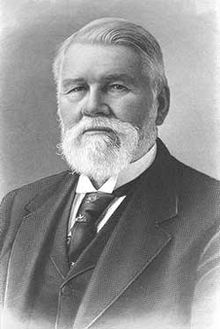
Dr Richard Jordan Gatling, inventor of the Gatling gun.
The Gatling gun was used some by the Union Army during the American Civil War. It wasn't officially accepted by the government until 1866, a year after that war had ended, but sales representatives of the manufacturer had "provided demonstrations" in battles near Petersburg, Virginia, and on gunboats. The Peruvian Navy and Army used Gatling guns against Chile in the War of the Pacific in 1879-1883.
Gatling's invention provided an enormous increase in firepower, but it wasn't all that practical. The gunpowder of the time created a significant output of smoke with a single shot. With the crank-fired weapon firing 100 or more rounds per minute, the gun was quickly enveloped by a thick cloud of smoke which drew attention to the weapon while obscuring the shooter's view downrange.
Armies of industrialized nations could effectively engage a Gatling gun crew in two ways. Snipers could target the men without being seen through the cloud of smoke surrounding the gun. Artillery could target the gun emplacement itself, firing from well outside the gun's range.
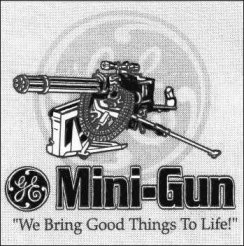
General Electric built the 20mm M61 Vulcan based on Gatling's design, and then scaled that down to the M134 Minigun firing 7.61x51mm. 10,000 of these were placed on helicopters, the AC-47 Spooky and AC-130 Spectre gunships, and other aircraft.
Colonial powers found it useful against natives, however. The Tsar's Imperial Russian Army purchased 400 Gatling guns to use against the Turkmen and other nomadic central Asian nomads. The British Army was probably the most enthusiastic users of the new weapons technology, employing Gatling guns against the Zulu and Ndebele people in southern Africa, the Bedouins in Arabia, and the Mahdists in Sudan. Winston Churchill's The River War can tell you some about that last one.
There were two major developments in 1884. First, Paul Vielle invented Poudre Blanche, "White Powder" as opposed to the smoke-producing black gunpowder. Poudre Blanche was made of 68.2% insoluble nitrocellulose, 29.8% soluble nitrocellulose gelatinized with ether, and 2% paraffin. It wasn't really powder, but neither was gunpowder. Poudre Blanche and its descendants take the form of small extruded pellets or granules. Compared to black powder, it provided three times the propellant power, produced almost no smoke, and did not produce thick hygroscopic fouling which draws and retains moisture and quickly jams moving parts. Most of the world quickly adapted Vielle's formulation calling it either smokeless propellant or its brand name such as Cordite. The U.S. is unusual in calling it "smokeless powder".
The second big development of 1884 was Sir Hiram Stevens Maxim's invention of a gun that used the force of its recoil to eject the spent cartridge case and load the next round. No crank, and much faster operation. Its barrel needed a cooling water jacket given the gun's rate of fire of 600 rounds per minute, ten per second. It was quickly popular with British colonial forces and deployed to central Africa, Rhodesia, Sudan, Singapore, and elsewhere.
John Browning and the Development of the M1911
Several national militaries applied the ideas of the Maxim design to handguns in the 1890s, leading to a number of designs. In late 1899 and early 1900 the U.S. military tested some self-loading handgun designs, including the Colt M1900, Mauser C96 (or "Broomhandle"), the Steyr Mannlicher M1894, and the DWN Luger.
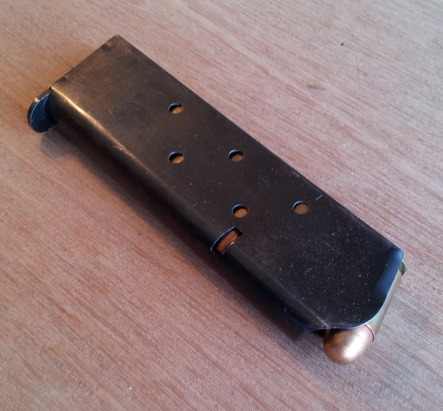
M1911 pistol magazine loaded with .45 ACP cartridges.
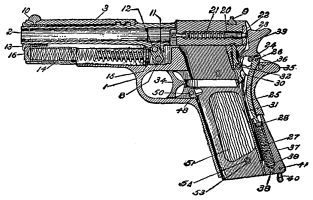
Cross-section diagram of the M1911 pistol from FM21-100, "The Soldier's Handbook", 1941.
The Spanish-American War had lasted just ten weeks in 1898. It was a rapid victory for the U.S., giving it control of Spanish colonies in the Caribbean and the western Pacific Ocean. That led into the much longer Philippine-American War of 1899-1902 and the even longer Moro Rebellion of 1899-1913.
The Moro Rebellion was an armed conflict between U.S. military forces and the Moro or Bangsamoro people of the southern Philippines. They were an indigenous people who had been converted to Islam in the 13th century. They were fanatically motivated and sometimes went into battle under the influence of pain-dulling drugs. The U.S. forces found that the then-standard .38 Long Colt cartridge was ineffective against massed Moro charges.

John Browning, inventor of the .45 ACP cartridge and the M1911 pistol along with many other firearms.
Colonel John T. Thompson of the Infantry and Major Louis Anatole LaGarde of the Medical Corps carried out tests at the Union Stock Yards of Chicago using live cattle and human cadavers. Thompson concluded that the army needed a pistol of semi-automatic operation capable of "well-directed rapid fire" firing a cartridge which "should not be of less than .45 caliber" and should be "a real man-stopper."
John Browning had developed a .41 caliber cartridge for Colt Firearms Company in 1904. The Thompson-LaGarde tests led the U.S. Army to request pistol designs firing a .45 caliber round in 1905. Browning's cartridge was scaled up and he designed a self-loading pistol to fire it.
The Army ran a series of tests. The competing designs were narrowed to Browning's Colt design and a pistol from the Savage corporation. In one of the last of these tests, in late 1910, six thousand rounds were to be fired through a single example of each design over a two-day period. The Savage design suffered from 37 malfunctions. Browning's Colt had none. When the Colt pistol began to heat up, they simply dunked it in water and cooled it back down before going back to shooting.
Adoption of the M1911 and World War I
The U.S. Army formally adopted Browning's Colt design in March of 1911, designating it the Model 1911 or M1911. The U.S. Navy and Marine Corps formally adopted it in 1913.
Over 68,500 M1911 pistols had been manufactured and delivered to the War Department by Colt and the U.S. Government's Springfield Armory by January 1917. At the end of that month, Germany resumed unrestricted submarine warfare. The Secretary of the German Empire, Arthur Zimmermann, sent what came to be known as the Zimmermann Telegram to the German ambassador to Mexico, instructing him to propose a military alliance. If Mexico came into the war on the German side and the U.S. was then defeated, Mexico would recover its lost territories in Texas, New Mexico, and Arizona. The ambassador was also to contact Japanese government officials to propose an alliance between Germany and Japan.
The Mexican government wanted nothing to do with the scheme. Meanwhile, British intelligence had intercepted and decrypted the message and gave it to U.S. President Woodrow Wilson. He revealed the contents to the American public, leading to strong support for the U.S. entry into the war. Wilson called for war on Germany, which the U.S. Congress formally declared on April 6, 1917.
By the summer of 1918 the U.S. was sending 10,000 troops to France every day. Several companies had been awarded contracts to manufacture M1911 pistols, starting with Remington-UMC and the North American Arms Company of Quebec. Further manufacturing contracts were later awarded to existing manufacturers of firearms (Savage Arms Company, Winchester Repeating Arms Company) and office and printing equipment (Burroughs Adding Machine Company, National Cash Register Company, Caron Brothers of Montreal, and Lanston Monotype Company), but the Armistice of November, 1918 was signed before any of them could start production.
Modification Between the Wars
Some very slight modifications were made to the design, largely to make it easier for men with smaller hands to shoot it accurately. The changes were completed in 1924, and in 1926 the slightly modified design was officially designated the M1911A1. There were no significant changes to internal parts, all of which can be interchanged between the M1911 and M1911A1.
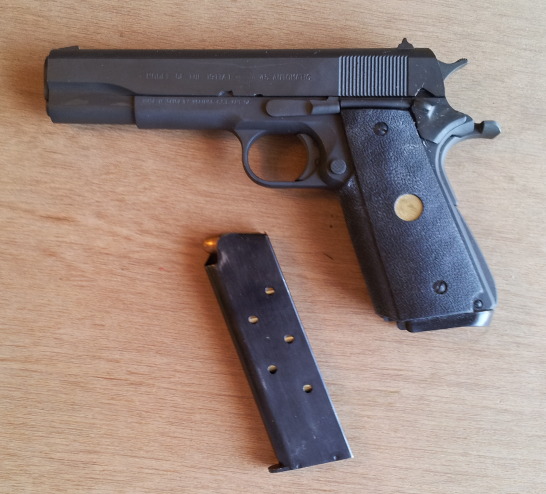
The picture here is of an M1911A1. On an M1911A1:
- The mainspring housing is slightly arched rather than straight and flush to the rear edge of the frame.
- The trigger is slightly shorter. That is, the original trigger protruded further forward out of the magazine well area. The new trigger is shorter so your trigger finger does not have to reach so far forward.
- Slight cutouts or reliefs have been made in the frame behind and above the trigger, so your trigger finger does not have to reach so much around a corner.
- The hammer spur is slightly shorter.
- The grip safety spur is longer. The pistol shown here has been customized with a "beavertail" grip safety spur that extends even further back with a wider blade shape.
- The front side blade is slightly thicker.
- The checkering on the grip panels is simpler. This pistol has been customized with a simple wraparound rubber grip.
Care and Use of the M1911
Original U.S. Government manuals are available for download
from the archive.org and ibiblio.org
sites:
WAR DEPARTMENT
BASIC FIELD MANUAL
SOLDIER'S HANDBOOK
1941
FM 21-100 is the overall manual for serving as a soldier. Chapter 6, "Arms and Equipment", contains sections on the nomenclature, care, and cleaning of the M1911 pistol and the M1 Garand rifle.
AFM 50-17
PISTOLS AND REVOLVERS
JULY, 1960
"This manual is in three parts and explains how to disassemble, assemble, fire, and take care of the Pistols, Automatic, Caliber .45, M1911 and M1911A1, and the revolver, Colt, Caliber .38, 2-Inch Barrel, Detective Special. It describes the parts and explains how they work. The step-by-step arrangement of the text provides for progressive training, promotes learning, and aids in organizing and presenting instruction."
SEPTEMBER, 1968
"Pistol, Caliber .45, Automatic, M1911A1, With Holster, Hip (1005-673-7965) and Pistol, Caliber .45, Automatic, M1911A1, With Holster, Shoulder (1005-561-2003)"
APRIL, 1968
"Direct Support, General Support,and Depot Maintenance Manual Including Repair Parts and Special Tool List for PISTOL, CALIBER .45, AUTOMATIC: M1911A1,WITH HOLSTER, HIP, W/E(1005-473-7905) PISTOL, CALIBER .45, AUTOMATIC: M1911A1, WITH HOLSTER, SHOULDER, W/E(1005-561-2003)"
The M1911 in World War II and Later
A number of countries including Argentina, Brazil, Mexico, and Spain purchased M1911 and M1911A1 pistols from Colt or manufactured them during the 1930s.
During the years leading up to World War II, the U.S. began accelerated production, with Colt manufacturing another 400,000 and firearms manufacturers Remington Rand and Ithaca manufacturing 900,000 and 400,000, respectively. The pre-war pistols were blued, but those manufactured for the war were parkerized. Other pages on this site show how to remove bluing and then how to parkerize an M1911.
Manufacturing contracts were canceled after the end of the war in 1945. Existing pistols were rebuilt, sometimes with some new replacement parts, refinished, and tested at service depots and arsenals.
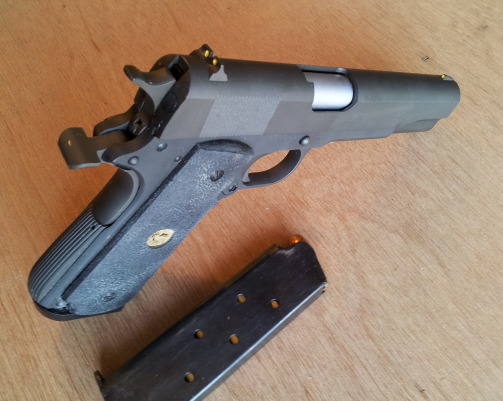
The M1911A1 continued as the standard sidearm of all U.S. forces through the Korean and Vietnam conflicts.
Political pressure through the late 1970s grew for replacing the M1911A1 with a pistol firing NATO's standard 9x19mm Parabellum cartridge. The U.S. Air Force selected the Baretta 92S-1. The Army disagreed, and its own competition in 1981 led to the official adoption in 1985 of the Baretta 92F.
Production of the Baretta increased through the late 1980s, and by the early 1990s most M1911A1s in regular units had been replaced by 9x19mm Barettas.
The Marine Expeditionary Units (Special Operations Capable) kept the M1911A1, as did USSOCOM units. The latest USMC M1911 variant is the MK45A1 Close Quarters Battle Pistol. They ordered another 12,000 of these in 2012.
Some USSOCOM units use the MK23 Mod 0 OHWS or Offensive Handgun Weapon System built by Heckler and Koch. It is largely based on the M1911 design.
In 2013 the U.S. Army began working to replace the M9 Baretta with a Modular Handgun System One major goal is to replace the 9x19mm round with one more effective in combat. Alternatives under consideration include the .45 ACP.
Norway, Spain, Argentina, Indonesia, and Taiwan locally manufactured their own variants for their military forces under contractual agreements with Colt.
Brazil, Thailand, and the Philippines still manufacture variants for both military and law enforcement use. Thailand also uses U.S.-manufactured M1911s supplied by the U.S. during the Vietnam War. The Philippine military buys some from Colt.
The U.S. gave Greece a large number of M1911s starting in 1946, and they are still used by the Hellenic Army.
Norinco, the China North Industries Corporation, manufactures a wide array of products including clones of the M1911A1. The pistol shown on this page is one of those Norinco clones. Trade regulations in 1993 stopped importation of the Norinco M1911A1 into the U.S.
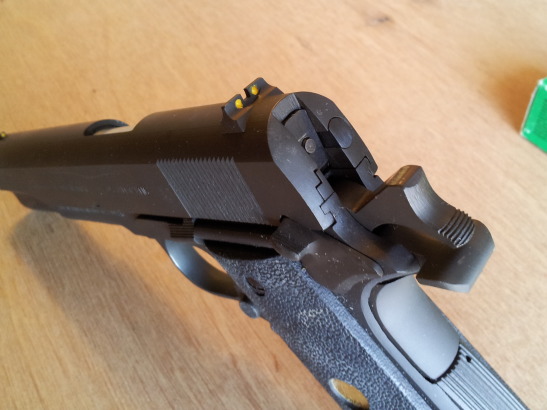
M1911A1 Grip Safety
The U.S. military had specified that their new .45 ACP pistol have both a grip safety and a manual safety.
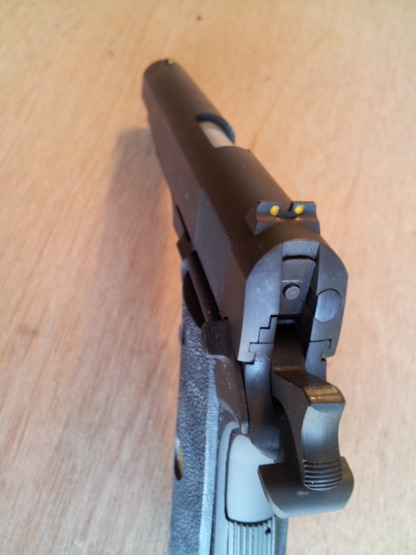
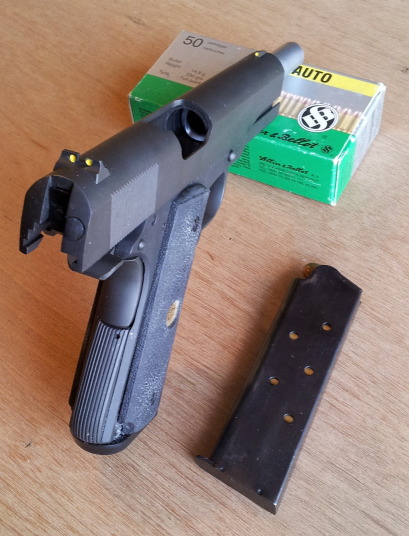
The grip safety is the piece with the spur extending to the rear below the hammer, curving down to form the top part of the rear of the grip. It pivots around the same same pin as the manual safety, and is intended to prevent the trigger from engaging the action unless the pistol is gripped correctly, depressing the lower part of the grip safety.
A basic safety test is to first ensure that the weapon is unloaded and then verify that the trigger cannot release the trigger if the lower segment of the grip safety is not, well, correctly gripped. The web between your thumb and first finger should depress the grip safety.
The manual safety is operated with the thumb when shooting left-handed. Custom ambidextrous safeties are available, they place a second manual safety lever on the right side.
The below pictures show, in order:
- Hammer down.
- Hammer cocked, manual safety engaged.
- Hammer cocked, manual safety disengaged, weapon is ready to fire.
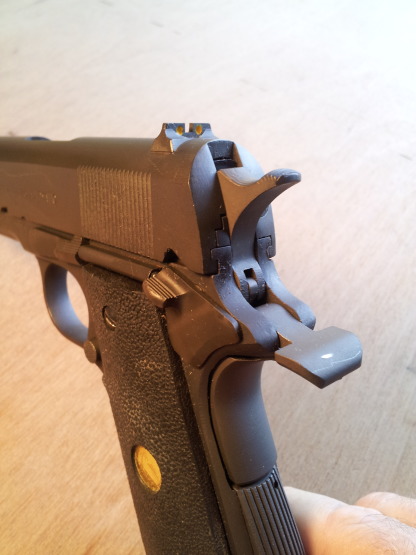
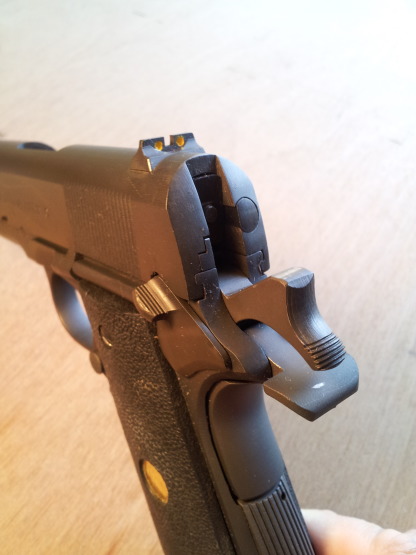
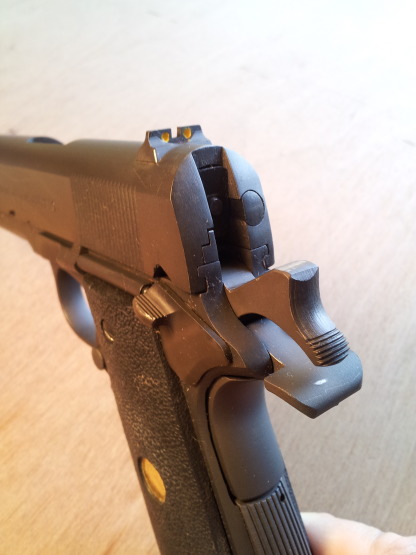
This M1911A1 has been modified with the addition of a beavertail style grip safety. Its spur extends further back and is about three times the width of the original. The intent is to prevent "hammer bite", the painful injury that would be caused by pinching the web between your thumb and index finger between the hammer and smaller standard spur.
The below pictures show, in order:
- Hammer cocked, manual safety engaged.
- Hammer cocked, manual safety disengaged, weapon is ready to fire.
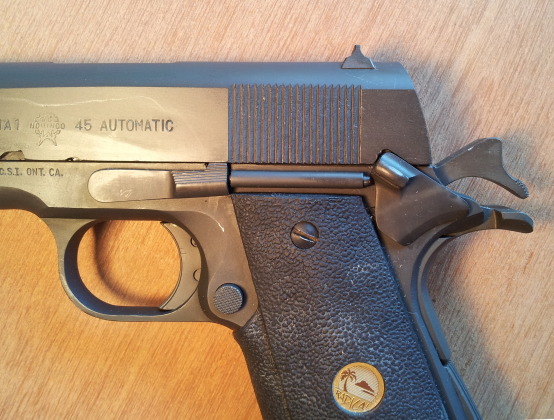
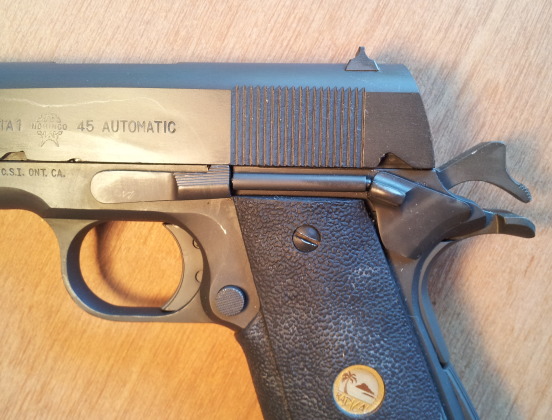
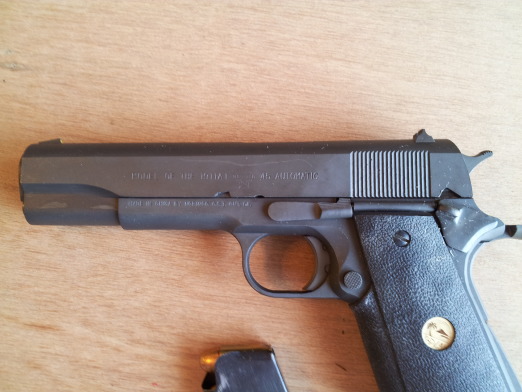
John Browning's design is still going strong after more than a century of service!
To learn more about the M1911 design, see:
How to field-strip
the M1911 pistol
The .45 ACP
cartridge
How to Remove Bluing
From an M1911
How to Parkerize
an M1911
